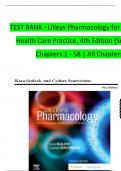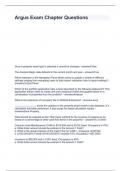lOMoAR cPSD| 3013804
lOMoARcPSD|30 13804
TEST BANK - Lilleys Pharmacology for
Health Care Practice, 4th Edition (Se
Chapters 1 - 58 | All Chapters
, lOMoAR cPSD| 3013804
TABLE OF CONTENTS
, lOMoAR cPSD| 3013804
Chapter 01: Nursing Practice in Canada and Drug Therapy
Sealock: Lilley’s Pharmacology for Canadian Health Care Practice, 4th Edition
MULTIPLE CHOICE
1. Which is a judgement about a particular patient’s potential need or problem?
a. A goal
b. An assessment
c. Subjective data
d. A nursing diagnosis
ANSWER: D
Nursing diagnosis is the phase of the nursing process during which a clinical judgement is made about
to heath conditions and life processes or vulnerability for that response.
DIF: Cognitive Level: Knowledge
2. The patient is to receive oral furosemide (Lasix) every day; however, because the patient is unable to
take medication orally, as ordered. The nurse needs to contact the physician. What type of problem is
a. A “right time” problem
b. A “right dose” problem
c. A “right route” problem
d. A “right medication” problem
ANSWER: C
This is a “right route” problem: the nurse cannot assume the route and must clarify the route with
“right time” problem because the ordered frequency has not changed. This is not a “right dose” prob
related to an inability to swallow. This is not a “right medication” problem because the medication o
the route.
DIF: Cognitive Level: Application
3. The nurse has been monitoring the patient’s progress on his new drug regimen since the first dose an
signs of possible adverse effects. What nursing process phase is the nurse practising?
a. Planning
b. Evaluation
c. Implementation
d. Nursing diagnosis
ANSWER: B
Monitoring the patient’s progress is part of the evaluation phase. Planning, implementation, and nurs
illustrated by this example.
DIF: Cognitive Level: Application
4. The nurse is caring for a patient who has been newly diagnosed with type 1 diabetes mellitus. Which
an outcome criterion for this patient?
a. The patient will follow instructions.
b. The patient will not experience complications.
c. The patient adheres to the new insulin treatment regimen.
d. The patient demonstrates safe insulin self-administration technique.
ANSWER: D
Having the patient demonstrate safe insulin self-administration technique is a specific and measurabl
, lOMoAR cPSD| 3013804
Copyright © 2021, Elsevier Inc. All rights reserved.
, lOMoAR cPSD| 3013804
6. The nurse is working during a very busy night shift, and the health care provider has just given the nur
over the telephone, but the nurse does not recall the route. What is the best way for the nurse to avo
a. Recopy the order neatly on the order sheet, with the most common route indicated
b. Consult with the pharmacist for clarification about the most common route
c. Call the health care provider to clarify the route of administration
d. Withhold the drug until the health care provider visits the patient
ANSWER: C
If a medication order does not include the route, the nurse must ask the health care provider to clarif
route of administration.
DIF: Cognitive Level: Application | Cognitive Level: Analysis
7. Which constitutes the traditional Five Rights of medication administration?
a. Right drug, right route, right dose, right time, and right patient
b. Right drug, the right effect, the right route, the right time, and the right patient
c. Right patient, right strength, right diagnosis, right drug, and right route
d. Right patient, right diagnosis, right drug, right route, and right time
ANSWER: A
The traditional Five Rights of medication administration were considered to be Right drug, Right route
and Right patient. Right effect, right strength, and right diagnosis are not part of the traditional Five R
DIF: Cognitive Level: Comprehension
8. What correctly describes the nursing process?
a. Diagnosing, planning, assessing, implementing, and finally evaluating
b. Assessing, then diagnosing, implementing, and ending with evaluating
c. A linear direction that begins with assessing and continues through
diagnosing, planning, and finally implementing
d. An ongoing process that begins with assessing and continues with
diagnosing, planning, implementing, and evaluating
ANSWER: D
The nursing process is an ongoing, flexible, adaptable, and adjustable five-step process that begins wi
through diagnosing, planning, implementing, and finally evaluating, which may then lead back to any
DIF: Cognitive Level: Application
9. When the nurse is considering the timing of a drug dose, which is most important to assess?
a. The patient’s identification
b. The patient’s weight
c. The patient’s last meal
d. Any drug or food allergies
ANSWER: C
The pharmacokinetic and pharmacodynamic properties of the drug need to be assessed with regard t
interactions or compatibility issues. The patient’s identification, weight, and drug or food allergies are
timing.
DIF: Cognitive Level: Application
10. The nurse is writing nursing diagnoses for a plan of care. Which reflects the correct format for her nur
a. Anxiety
b. Anxiety related to new drug therapy
c. Anxiety related to anxious feelings about drug therapy, as evidenced
by statements such as “I’m upset about having to give myself shots”
, lOMoAR cPSD| 3013804
DIF: Cognitive Level: Analysis
Copyright © 2021, Elsevier Inc. All rights reserved.
, lOMoAR cPSD| 3013804
Chapter 02: Pharmacological Principles
Sealock: Lilley’s Pharmacology for Canadian Health Care Practice, 4th Edition
MULTIPLE CHOICE
1. A patient is receiving two different drugs, which, at their current dose forms and dosages, are both ab
in identical amounts. Which term best denotes that the drugs have the same absorption rates?
a. Equivalent
b. Synergistic
c. Compatible
d. Bioequivalent
ANSWER: D
Two drugs absorbed into the circulation at the same amount (in specific dosage forms) have the same
are bioequivalent. “Equivalent” is incorrect because the term “bioavailability” is used to express the e
“Synergistic” is incorrect because this term refers to two drugs given together whose resulting effect
the effects of each drug given alone. “Compatible” is incorrect because this term is a general term use
substances do not have a chemical reaction when mixed (or given, in the case of drugs) together.
DIF: Cognitive Level: Comprehension
2. A patient is receiving medication via intravenous injection. Which information should the nurse provid
a. The medication will cause fewer adverse effects when given intravenously.
b. The medication will be absorbed slowly into the tissues over time.
c. The medication’s action will begin faster when given intravenously.
d. Most of the drug is inactivated by the liver before it reaches the target area.
ANSWER: C
Intravenous injections are the fastest route of absorption. The intravenous route does not affect the n
effects, the intravenous route is not a slow route of absorption, and the intravenous route does not c
drug by the liver before it reaches the target area.
DIF: Cognitive Level: Comprehension
3. Which is true regarding parenteral drugs?
a. They bypass the first-pass effect.
b. They decrease blood flow to the stomach.
c. They are altered by the presence of food in the stomach.
d. They exert their effects while circulating in the bloodstream.
ANSWER: A
Drugs given by the parenteral route bypass the first-pass effect, but they still must be absorbed into c
can exert their effects. Enteral drugs (drugs taken orally), not parenteral drugs, decrease blood flow to
altered by the presence of food in the stomach. Parenteral drugs must be absorbed into cells and tiss
before they can exert their effects; they do not exert their effects while circulating in the bloodstream
DIF: Cognitive Level: Analysis
4. A drug’s half-life is best defined as
a. The time it takes for the drug to elicit half its therapeutic response.
b. The time it takes one-half of the original amount of a drug to reach the
target cells.
c. The time it takes one-half of the original amount of a drug to be removed from
the body.
d. The time it takes one-half of the original amount of a drug to be absorbed into
the circulation.
, lOMoAR cPSD| 3013804
Copyright © 2021, Elsevier Inc. All rights reserved.
, lOMoAR cPSD| 3013804
6. A drug interacts with enzymes by
a. altering cell membrane permeability.
b. “fooling” a receptor on the cell wall.
c. enhancing the drug’s effectiveness within the cells.
d. “fooling” the enzyme into binding with it instead of its normal target cell.
ANSWER: D
When drugs interact with enzymes, they inhibit the action of a specific enzyme by “fooling” the enzym
instead of to its normal target cell. Thus, the target cells are protected from the action of the enzyme
The alteration of cell membrane permeability, the “fooling” of a receptor on the cell wall, and the enh
effectiveness of drugs within cells do not occur with selective enzyme interactions.
DIF: Cognitive Level: Comprehension
7. When administering a new medication to a patient, the nurse reads that it is highly protein bound. W
result from this protein binding?
a. Renal excretion will take longer.
b. The drug will be metabolized quickly.
c. The duration of action of the medication will be longer.
d. The duration of action of the medication will be shorter.
ANSWER: C
Drugs that are bound to plasma proteins are characterized by a longer duration of action. Protein bin
renal excretion longer and does not increase metabolism of the drug. Protein binding of a drug means
action is longer, not shorter.
DIF: Cognitive Level: Application
8. When monitoring a patient on an insulin drip to reduce blood glucose levels, the nurse notes that the
level is extremely low, and the patient is lethargic and difficult to awaken. Which adverse drug reactio
observing?
a. An adverse effect
b. An allergic reaction
c. An idiosyncratic reaction
d. A pharmacological reaction
ANSWER: D
A pharmacological reaction is an extension of the drug’s normal effects in the body. In this case, the in
blood glucose levels too much. An adverse effect is a predictable, well-known adverse drug reaction t
changes in patient management. An allergic reaction (also known as a hypersensitivity reaction) involv
system. An idiosyncratic reaction is unexpected and is defined as a genetically determined abnormal r
of a drug.
DIF: Cognitive Level: Comprehension
9. A patient is experiencing chest pain and needs to take a sublingual form of nitroglycerin. Where shoul
to place the tablet?
a. Under the tongue
b. In the space between the cheek and gum
c. At the back of the throat, for easy swallowing
d. On a non-hairy area on the chest
ANSWER: A
Drugs taken by the sublingual route are placed under the tongue. Placing the tablet in the space be
done for the buccal route; placing the tablet at the back of the throat (for easy swallowing) is done i
the tablet on a non-hairy area on the chest is done in the topical or transdermal route.
, lOMoAR cPSD| 3013804
Copyright © 2021, Elsevier Inc. All rights reserved.





